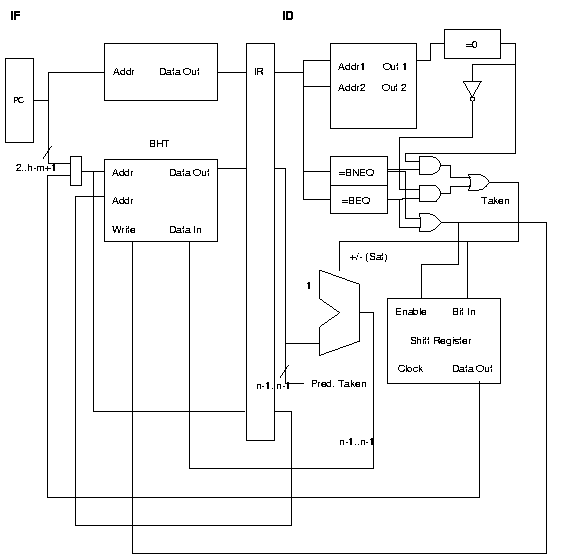
Some points:
muld is forced to wait a cycle.
ld, is not fetched until after
the branch leaves ID.
Time 0 1 2 3 4 5 6 7 8 9 10 11 12 13 14 15 16 17 18 19 20 21 22 23 24 25 26 27 28 muld IF ID 5:A1 5:A2 5:A5 5:A4 5:WB addd IF ID 3:RS 3:RS 3:RS 3:RS 3:A1 3:A2 3:A3 3:A4 3:WB muld IF ID 6:RS 6:RS 6:RS 6:M1 6:M2 6:M3 6:M4 6:WB 6:WB subd IF ID 4:RS 4:RS 4:RS 4:A1 4:A2 4:A3 4:A4 4:WB 4:WB loop: ld IF ID 2:EX 2:MI 2:WI IF ID subd IF ID 3:RS 3:RS 3:A1 3:A2 3:A3 3:A4 3:WB ld IF ID 1:EX 1:MI 1:WB subd IF ID 4:RS 4:RS 4:A1 4:A2 4:A3 4:A4 4:WB ld IF ID 2:EX 2:MI 2:WB subd IF ID 3:RS 3:A1 3:A2 3:A3 3:A4 3:WB subi IF ID 1:EX 1:MI 1:WB addi IF ID 2:EX 2:MI 2:WB bnez IF ID 1:EX 1:MI 1:WB
Time 11 12 13 14 15 16 17 18 19 20 21 22 23 24 25 26 27 28 muld addd 3:WB muld 6:WB 6:WB subd 4:A4 4:WB 4:WB loop: ld IF ID subd 3:RS 3:RS 3:A1 3:A2 3:A3 3:A4 3:WB ld ID 1:EX 1:MI 1:WB subd IF ID 4:RS 4:RS 4:A1 4:A2 4:A3 4:A4 4:WB ld IF ID 2:EX 2:MI 2:WB subd IF ID 3:RS 3:A1 3:A2 3:A3 3:A4 3:WB subi IF ID 1:EX 1:MI 1:WB addi IF ID 2:EX 2:MI 2:WB bnez IF ID 1:EX 1:MI 1:WB
The BHT has a separate read and write port (so that one entry can be read while another is updated). The BHT address is the concatenation of h-m PC bits and m bits from the shift register. The BHT entry and the BHT entry address are clocked into the IF/ID latch.
The prediction is made in the ID stage simply by looking at the most significant bit of the BHT entry. An updated BHT entry is generated by adding or subtracting 1, based on the branch outcome. (In any real branch prediction scheme we would not know the outcome until several cycles later.) Using the address in the IF/ID latch, the updated entry is written to the BHT (at the end of ID) using the address from the latch. (It's important to write the entry to the same address it was read from, of course.)
The shift register is updated at the end of ID. The register shifts only if the "enable" line is asserted.
The solution below would have received full credit, but it does have
a problem: If there are two consecutive branches, the shift register
value used for the second branch will not be correct. How could
this problem be fixed? Also, how would the design be changed if
the "taken" signal were available only after ID?




| David M. Koppelman - koppel@ee.lsu.edu | Modified 28 Apr 1997 18:50 (23:50 UTC) |